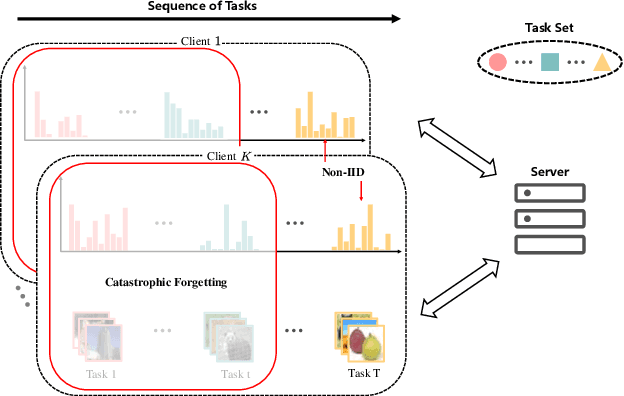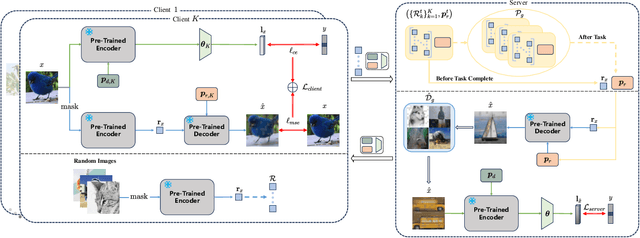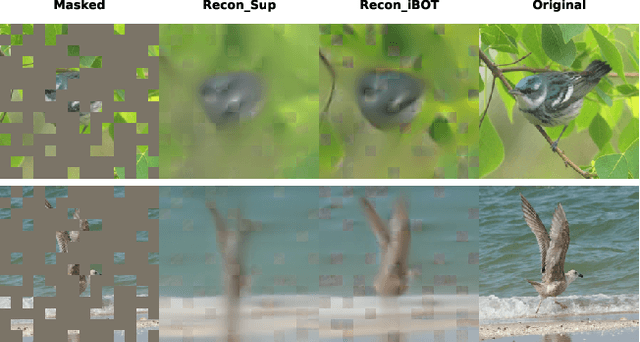Xiangfeng Wang
A Survey of Automatic Prompt Engineering: An Optimization Perspective
Feb 17, 2025Abstract:The rise of foundation models has shifted focus from resource-intensive fine-tuning to prompt engineering, a paradigm that steers model behavior through input design rather than weight updates. While manual prompt engineering faces limitations in scalability, adaptability, and cross-modal alignment, automated methods, spanning foundation model (FM) based optimization, evolutionary methods, gradient-based optimization, and reinforcement learning, offer promising solutions. Existing surveys, however, remain fragmented across modalities and methodologies. This paper presents the first comprehensive survey on automated prompt engineering through a unified optimization-theoretic lens. We formalize prompt optimization as a maximization problem over discrete, continuous, and hybrid prompt spaces, systematically organizing methods by their optimization variables (instructions, soft prompts, exemplars), task-specific objectives, and computational frameworks. By bridging theoretical formulation with practical implementations across text, vision, and multimodal domains, this survey establishes a foundational framework for both researchers and practitioners, while highlighting underexplored frontiers in constrained optimization and agent-oriented prompt design.
GraphThought: Graph Combinatorial Optimization with Thought Generation
Feb 17, 2025Abstract:Large language models (LLMs) have demonstrated remarkable capabilities across various domains, especially in text processing and generative tasks. Recent advancements in the reasoning capabilities of state-of-the-art LLMs, such as OpenAI-o1, have significantly broadened their applicability, particularly in complex problem-solving and logical inference. However, most existing LLMs struggle with notable limitations in handling graph combinatorial optimization (GCO) problems. To bridge this gap, we formally define the Optimal Thoughts Design (OTD) problem, including its state and action thought space. We then introduce a novel framework, GraphThought, designed to generate high-quality thought datasets for GCO problems. Leveraging these datasets, we fine-tune the Llama-3-8B-Instruct model to develop Llama-GT. Notably, despite its compact 8B-parameter architecture, Llama-GT matches the performance of state-of-the-art LLMs on the GraphArena benchmark. Experimental results show that our approach outperforms both proprietary and open-source models, even rivaling specialized models like o1-mini. This work sets a new state-of-the-art benchmark while challenging the prevailing notion that model scale is the primary driver of reasoning capability.
Generative Multi-Agent Collaboration in Embodied AI: A Systematic Review
Feb 17, 2025Abstract:Embodied multi-agent systems (EMAS) have attracted growing attention for their potential to address complex, real-world challenges in areas such as logistics and robotics. Recent advances in foundation models pave the way for generative agents capable of richer communication and adaptive problem-solving. This survey provides a systematic examination of how EMAS can benefit from these generative capabilities. We propose a taxonomy that categorizes EMAS by system architectures and embodiment modalities, emphasizing how collaboration spans both physical and virtual contexts. Central building blocks, perception, planning, communication, and feedback, are then analyzed to illustrate how generative techniques bolster system robustness and flexibility. Through concrete examples, we demonstrate the transformative effects of integrating foundation models into embodied, multi-agent frameworks. Finally, we discuss challenges and future directions, underlining the significant promise of EMAS to reshape the landscape of AI-driven collaboration.
SkyRover: A Modular Simulator for Cross-Domain Pathfinding
Feb 13, 2025Abstract:Unmanned Aerial Vehicles (UAVs) and Automated Guided Vehicles (AGVs) increasingly collaborate in logistics, surveillance, inspection tasks and etc. However, existing simulators often focus on a single domain, limiting cross-domain study. This paper presents the SkyRover, a modular simulator for UAV-AGV multi-agent pathfinding (MAPF). SkyRover supports realistic agent dynamics, configurable 3D environments, and convenient APIs for external solvers and learning methods. By unifying ground and aerial operations, it facilitates cross-domain algorithm design, testing, and benchmarking. Experiments highlight SkyRover's capacity for efficient pathfinding and high-fidelity simulations in UAV-AGV coordination. Project is available at https://sites.google.com/view/mapf3d/home.
TrackDiffuser: Nearly Model-Free Bayesian Filtering with Diffusion Model
Feb 08, 2025



Abstract:State estimation remains a fundamental challenge across numerous domains, from autonomous driving, aircraft tracking to quantum system control. Although Bayesian filtering has been the cornerstone solution, its classical model-based paradigm faces two major limitations: it struggles with inaccurate state space model (SSM) and requires extensive prior knowledge of noise characteristics. We present TrackDiffuser, a generative framework addressing both challenges by reformulating Bayesian filtering as a conditional diffusion model. Our approach implicitly learns system dynamics from data to mitigate the effects of inaccurate SSM, while simultaneously circumventing the need for explicit measurement models and noise priors by establishing a direct relationship between measurements and states. Through an implicit predict-and-update mechanism, TrackDiffuser preserves the interpretability advantage of traditional model-based filtering methods. Extensive experiments demonstrate that our framework substantially outperforms both classical and contemporary hybrid methods, especially in challenging non-linear scenarios involving non-Gaussian noises. Notably, TrackDiffuser exhibits remarkable robustness to SSM inaccuracies, offering a practical solution for real-world state estimation problems where perfect models and prior knowledge are unavailable.
Verbalized Bayesian Persuasion
Feb 03, 2025Abstract:Information design (ID) explores how a sender influence the optimal behavior of receivers to achieve specific objectives. While ID originates from everyday human communication, existing game-theoretic and machine learning methods often model information structures as numbers, which limits many applications to toy games. This work leverages LLMs and proposes a verbalized framework in Bayesian persuasion (BP), which extends classic BP to real-world games involving human dialogues for the first time. Specifically, we map the BP to a verbalized mediator-augmented extensive-form game, where LLMs instantiate the sender and receiver. To efficiently solve the verbalized game, we propose a generalized equilibrium-finding algorithm combining LLM and game solver. The algorithm is reinforced with techniques including verbalized commitment assumptions, verbalized obedience constraints, and information obfuscation. Numerical experiments in dialogue scenarios, such as recommendation letters, courtroom interactions, and law enforcement, validate that our framework can both reproduce theoretical results in classic BP and discover effective persuasion strategies in more complex natural language and multi-stage scenarios.
FPPL: An Efficient and Non-IID Robust Federated Continual Learning Framework
Nov 04, 2024Abstract:Federated continual learning (FCL) aims to learn from sequential data stream in the decentralized federated learning setting, while simultaneously mitigating the catastrophic forgetting issue in classical continual learning. Existing FCL methods usually employ typical rehearsal mechanisms, which could result in privacy violations or additional onerous storage and computational burdens. In this work, an efficient and non-IID robust federated continual learning framework, called Federated Prototype-Augmented Prompt Learning (FPPL), is proposed. The FPPL can collaboratively learn lightweight prompts augmented by prototypes without rehearsal. On the client side, a fusion function is employed to fully leverage the knowledge contained in task-specific prompts for alleviating catastrophic forgetting. Additionally, global prototypes aggregated from the server are used to obtain unified representation through contrastive learning, mitigating the impact of non-IID-derived data heterogeneity. On the server side, locally uploaded prototypes are utilized to perform debiasing on the classifier, further alleviating the performance degradation caused by both non-IID and catastrophic forgetting. Empirical evaluations demonstrate the effectiveness of FPPL, achieving notable performance with an efficient design while remaining robust to diverse non-IID degrees. Code is available at: https://github.com/ycheoo/FPPL.
Masked Autoencoders are Parameter-Efficient Federated Continual Learners
Nov 04, 2024



Abstract:Federated learning is a specific distributed learning paradigm in which a central server aggregates updates from multiple clients' local models, thereby enabling the server to learn without requiring clients to upload their private data, maintaining data privacy. While existing federated learning methods are primarily designed for static data, real-world applications often require clients to learn new categories over time. This challenge necessitates the integration of continual learning techniques, resulting in federated continual learning (FCL). Although advanced prompt-based continual learning methods leverage pre-trained transformers to mitigate catastrophic forgetting, they do not adequately address the non-IID challenges in federated learning. To address both catastrophic forgetting and non-IID issues, we propose to use masked autoencoders (MAEs) as parameter-efficient federated continual learners, called pMAE. pMAE learns reconstructive prompt on the client side through image reconstruction using MAEs. On the server side, it reconstructs the uploaded restore information to capture the data distribution across previous tasks and different clients, using these reconstructed images to finetune discriminative prompt and classifier parameters designed for classification, thereby alleviating catastrophic forgetting and non-IID challenges on a global scale. Experimental results demonstrate that pMAE achieves performance comparable to existing prompt-based methods and can enhance their effectiveness, particularly when using self-supervised pre-trained transformers as the backbone. Code is available at: https://github.com/ycheoo/pMAE.
Interactive 3D Medical Image Segmentation with SAM 2
Aug 05, 2024Abstract:Interactive medical image segmentation (IMIS) has shown significant potential in enhancing segmentation accuracy by integrating iterative feedback from medical professionals. However, the limited availability of enough 3D medical data restricts the generalization and robustness of most IMIS methods. The Segment Anything Model (SAM), though effective for 2D images, requires expensive semi-auto slice-by-slice annotations for 3D medical images. In this paper, we explore the zero-shot capabilities of SAM 2, the next-generation Meta SAM model trained on videos, for 3D medical image segmentation. By treating sequential 2D slices of 3D images as video frames, SAM 2 can fully automatically propagate annotations from a single frame to the entire 3D volume. We propose a practical pipeline for using SAM 2 in 3D medical image segmentation and present key findings highlighting its efficiency and potential for further optimization. Concretely, numerical experiments on the BraTS2020 and the medical segmentation decathlon datasets demonstrate that SAM 2 still has a gap with supervised methods but can narrow the gap in specific settings and organ types, significantly reducing the annotation burden on medical professionals. Our code will be open-sourced and available at https://github.com/Chuyun-Shen/SAM_2_Medical_3D.
In-Context Former: Lightning-fast Compressing Context for Large Language Model
Jun 19, 2024



Abstract:With the rising popularity of Transformer-based large language models (LLMs), reducing their high inference costs has become a significant research focus. One effective approach is to compress the long input contexts. Existing methods typically leverage the self-attention mechanism of the LLM itself for context compression. While these methods have achieved notable results, the compression process still involves quadratic time complexity, which limits their applicability. To mitigate this limitation, we propose the In-Context Former (IC-Former). Unlike previous methods, IC-Former does not depend on the target LLMs. Instead, it leverages the cross-attention mechanism and a small number of learnable digest tokens to directly condense information from the contextual word embeddings. This approach significantly reduces inference time, which achieves linear growth in time complexity within the compression range. Experimental results indicate that our method requires only 1/32 of the floating-point operations of the baseline during compression and improves processing speed by 68 to 112 times while achieving over 90% of the baseline performance on evaluation metrics. Overall, our model effectively reduces compression costs and makes real-time compression scenarios feasible.
 Add to Chrome
Add to Chrome Add to Firefox
Add to Firefox Add to Edge
Add to Edge